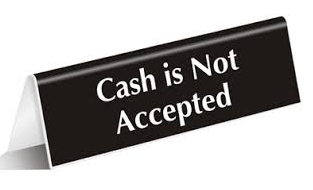A CBS special report on mobile wallets went to China and asked, “What do you think of people who use cash to pay for things?” One Chinese millennial responded, “That’s rare and weird, only the elderly and people who don’t know how to use a phone use cash.”
As you probably know by now, mobile wallets store a customer’s payment data on their mobile device instead of their back pocket or purse. But what do these “virtual wallets” mean for your business? Can they actually improve your profitability, and how? And, what’s this digital shift all about, is it leading to true cashless societies?
In some European stores and restaurants, cash is no longer king and rapidly becoming a pariah. All around the world, consumers and businesses increasingly rely either on plastic or mobile wallets for financial transactions. Number-wise, global transactions via mobile wallets are expected to top over $3 trillion by 2022 according to an early 2017 report by Zion Market Research. Zion’s report also indicates mobile wallets were responsible for $594 billion in 2016 and predicts a compounded annual growth rate of 32%. Another report from Forrester Research sets the US share of mobile wallet spending at $112 billion in 2016, forecasting a more conservative growth rate of 20% per year through 2021.
Are Mobile Wallets just for Transferring Money?
All mobile wallets serve to electronically transfer money from one account to another. How they actually work can vary. Nearly all mobile wallets support online transactions. Many also support Point of Sale (POS), Mobile Point of Sale (mPOS), QR Codes, and Near Field Communication (NFC) payments supported by Android Pay, Apple Pay and Samsung Pay.
While not exactly new, mobile wallets are convenient, easy to use, and can make checkout lines a little faster. There is a value in that – it is important – but are mobile wallets only another way for people to make payments? Literally, hundreds of companies have jumped into the mobile wallet market, but why?
Mobile Wallets for Customer Data
Mobile wallets make it possible for businesses to get very personal with their customers, to see what they buy, how frequently and more. How much is that customer data worth? Financial Times built a neat little tool in 2013 to calculate how much your personal data was worth in the early days of Big Data – probably less than $2.00. But then in 2014, there’s the story of Shawn Buckles who sold his data to The Next Web for $480! At that rate, one might start investing in their own personal data! Assessments by Trustwave place the average value of personally identifiable information(PII) at over $1,000 per person in 2017. Suddenly, all of this little data has substantial value in the hands of those who know how to use it.
When a customer uses a mobile wallet like Android Pay to make a purchase, Google is getting most of the PII. Personally identifiable information, per Wikipedia, is “information that can be used on its own or with other information to identify, contact, or locate a single person, or to identify an individual in context.” Context includes whether they are male, female, married or single, possibly have children, own a home, a vehicle, what type of vehicle, etc. Of course, this brings us deep into the area of privacy laws, suffice that all of these things can be associated with the IP address of each and every mobile device.
Mobile Wallets for Customer Loyalty
If you are like Google or Amazon you are also looking for ways to acquire this data. A customer loyalty program is a good place to start. It costs at least five times more to attract a new customer than to retain a current one. Customer loyalty programs are popular – sometimes they involve “free stuff” or at least discounts and incentives for shopping at a store. As of 2017, Americans were enrolled in over 3.8 billion customer loyalty programs according to Colloguy, with some enrolled in as many as 30 or more.
Companies that develop custom-built mobile wallets – complete with their own branding and loyalty programs – get the benefits of a wide variety of features like:
- Direct to customer messaging
- Shopping checklists
- Customer product reviews
- Real-time order tracking
- eCoupons
- Personalized recommendations based on previous purchasing history
- In-store proximity alerts or guidance to find specific products
- Social sharing tools
Once your company gets its own mobile wallet, these can all be part of your loyalty program and help your business to:
- Increase how frequently customers shop with you.
- Increase their average purchase.
- Gain new customers by expanding word of mouth advertising via social sharing.
- Improve inventory turnover rates and reduce storage requirements, where applicable.
Costs of a Custom-Built Mobile Wallet
The design and development of a mobile wallet with a customer loyalty program includes all of the same factors that go into mobile app development. A virtual wallet is a mobile app. It’s impossible to tell you what the cost is without knowing all of the features you want to include and whether want it to be compatible with Android, iOS or both. The location of your developer and other factors can also have a dramatic impact on your cost. It is a lot like building a house – one story? Two stories? One bedroom? Four bedrooms? One or two car garage?
To help narrow the cost down, from our many years of experience the cost of a high quality entry-level or Minimum Viable Product (MVP) app starts around $50,000 and can go to $200,000. For more detailed information, please check out the following:
- The Mobile App Cost Estimation Explained
- Comprehensive Guide to the Cost to Develop an App
- Understanding Your Minimum Viable Product
ROI for Your Mobile Wallet and Loyalty Program
Custom development and design of your mobile wallet and customer loyalty program involves a large one-time, upfront expense. Additional ongoing costs for support, updates and new features are likely to run 20 to 40% of initial costs on an annual basis. You’ll also have costs for managing customer benefits through your loyalty program. This includes Marketing time to updating various specials – and any discounts that may eat into your margins. However, those costs can be offset some by promoting products you purchase with better profit margins. Leastwise, you have the ability to select what your loss leaders will be in a way that ultimately increases how much your customers spend with you.
Example:
Let’s consider a company with 10 mid-sized retail outlets. Each attracts 2,000 shoppers weekly who spend an average of $100 each. The company’s annual sales equate to $104 million with a 6% profit margin ($6.24 million). The company decides it will invest $120,000 into a custom-built mobile wallet that includes a customer loyalty program and $40,000 yearly to keep it updated and to add new features.
Based on that, let’s explore a conservative growth rate of 3% on (1) an increase in the number of customers per week per store, and (2) an increase in their average purchase. That’s entirely realistic without relying upon Starbuck-like success.
A simple 3% increase in weekly customers yields over $3.1 million more in annual sales or $187,000 in profit. That pays for the initial cost of the mobile wallet within about 8 months. Adding an extra $3 to the average purchase improves overall annual profits by over $380,000. You’d be correct to note that this doesn’t include promotions costs that eat into your profit margins. However, smart inventory management software can help you to pick promotions that reduce shelf life, improve turnover and reduce write-off and spoilage.
Scale of Operations
As reflected above, a custom-made mobile wallet featuring a potent customer loyalty program is a significant investment. It requires a certain scale of operations to be viable. While even smaller businesses will realize a profit on a long enough time scale, odds are they could put that six-figure investment to better use for a faster return. Conversely, this gives larger businesses more to think about.
Merely being able to invest in a mobile app is itself a huge advantage. It is an advantage that could be put to use by working with smaller establishments on either a white label, royalty (or commissions) basis. One arrangement could see this applied to leading a community-based retailer loyalty program.
Amazon Go – The Future of Retail?
When attempting to peer into the future to see what retail stores of tomorrow look like, Amazon Go should catch your eye. This one-of-a-kind store in Seattle may be small, but lets people with the Amazon Go App walk in, pick up what they want and walk out – without standing in line. A host of cameras and sensors watch everything customers pick up and put down, and automatically charge them for what they leave the store with. Regardless of whether Amazon does with Whole Foods as they’ve done with Amazon Go, retailers also have to watch Walmart. Few companies have placed so much pressure on retailers as these two behemoths. As William Gibson says, “The future is already here – it’s just not very evenly distributed.”
Moving Toward a Cashless Society?

Beyond the sheer convenience of not having to carry cash, other factors also play into reducing our dependence on the almighty dollar bill. For the United States, it may be too early to talk about it being a “cashless society.” Even so, according to a Reuters survey, about a third of Americans would be happy to transition to a cashless society. One in five Americans already rarely use cash. While America has the technology to be a cashless society, trust that corporations and government will protect and not share private data is a major hurdle still to cross – and from several angles.
Things are very different in Sweden, China and several other countries in Europe and Asia. Sweden is a lot like Amazon Go, as according to the BBC, only 1% of its financial transactions were conducted with Swedish Krona notes, öre coins or Euros. A report by MasterCard shows Denmark, Belgium, France, Iceland, Singapore and Canada are following suit in going cashless. In China today? Well, it’s probably best to hear it for yourself…
Where our earlier reference to Zion Market Research projecting mobile wallet spending to exceed $3 trillion by 2022, China alone exceeded $12 trillion in 2017. It is one good example of how we are entering an era where technology no longer progresses on linear, but exponential terms.






[…] Cashing in with Mobile Wallets and Customer Loyalty Programs […]